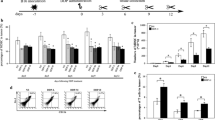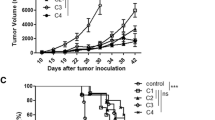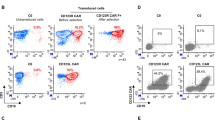Summary
A murine plasmacytoma MOPC 104E (MOPC) is highly sensitive to chemotherapeutic agents such as cyclophosphamide and mitomycin C as well as to immunotherapy (OK-432-combined adoptive immunotherapy using interleukin-2-cultured killer cells). In the present study, we prepared cyclophosphamide-resistant MOPC cells (MOPC-CPA/R) by serial in vivo passage of tumor cells following cyclophosphamide treatment. The in vivo sensitivity of MOPC-CPA/R to mitomycin C or to immunotherapy (OK-432-combined adoptive immunotherapy) was significantly decreased compared to the parent MOPC. In vitro experiments showed that MOPC-CPA/R were more resistant (five-fold) to lysis by cultured immune spleen cells than MOPC. Inhibition of the lytic activity of cultured immune spleen cells against MOPC was significantly increased (P <0.05) by the addition of unlabeled MOPC compared to unlabeled MOPC-CPA/R. These results suggest that MOPC-CPA/R express weaker antigenicity than MOPC. However, the transfer of immune spleen cells cultured with tumor extract derived from MOPC-CPA/R significantly prolonged the survival of MOPC-CPA/R-inoculated mice. Thus, by repeated cyclophosphamide treatment, tumor cells with low-antigenicity were selected. These tumor cells had lower sensitivity to another chemotherapeutic agent and immunotherapy. Such an immunological response may play an important role in cancer therapy.
Similar content being viewed by others
References
Akiyoshi T, Arinaga S, Tsuji H (1987) Augmentation of the generation of cell-mediated cytotoxicity in culture by mitomycin C. Cancer Immunol Immunother 24: 259
Bookman MA, Swerdlow R, Matis LA (1987) Adoptive chemoimmunotherapy of murine leukemia with helper T lymphocyte clones. J Immunol 139: 3166
Boon T, Kellermann O (1977) Rejection by syngeneic mice of cell variants obtained by mutagenesis of a malignant teratocarcinoma cell line. Proc Natl Acad Sci USA 74: 272
Fojo AT, Ueda K, Slamon DJ, Poplack DG, Gottesman MM, Pastan I (1987) Expression of a multidrug-resistance gene in human tumors and tissues. Proc Natl Acad Sci USA 84: 265
Gerhartz HH, Liss E, Schmidt H (1979) Cyclophosphamide-resistant Yoshida ascites tumor cells and their cross resistance to some alkylating agents. J Cancer Res Clin Oncol 94: 257
Ghaffar A, Sigel MM, Huggins EM (1985) Resistance of helper T lymphocytes to cyclophosphamide. J Immunopharmacol 7: 449
Hori T, Kan N, Nio Y, Tsuchitani T, Inamoto T, Kodama H, Tobe T (1986) Augmentation by OK-432 of cytotoxic activities of lymphocytes in carcinomatous pleural effusions, and its application for adoptive immunotherapy: In: Tobe T (ed) New applications of OK-432. Excerpta Medica, Tokyo, p 132
Kan N, Ohgaki K, Inamoto T, Kodama H (1984) Antitumor and therapeutic effects of spleen cells from tumor-bearing mice cultured with T cell growth factor and soluble tumor extract. Cancer Immunol Immunother 18: 215
Kan N, Inamoto T, Hori T, Nio Y, Tsuchitani T, Kodama H, Tobe T, Ohgaki K (1985) Adoptive immunotherapy of murine tumor using cultured syngeneic tumor-bearer-spleen cells. II: Therapeutic effect of cultured lymphocytes against malignant ascites and its augmentation by streptococcal preparation, OK-432. J Jpn Soc Cancer Ther 20: 784
Kan N, Okino T, Nakanishi M, Satoh K, Ohgaki K, Tobe T (1989) In vivo and in vitro synergistic antitumor effect of interleukin-2-cultured tumor-bearer spleen cells and immune fresh spleen cells. Cancer Immunol Immunother 28: 260
Kan N, Okino T, Nakanishi M, Satoh K, Mise K, Yamasaki S, Teramura Y, Ohgaki K, Tobe T (1989) Therapeutic efficacy of sequential therapy with OK-432, cyclophosphamide, IL2-cultured lymphocytes and in vivo IL2 against advanced murine plasmacytoma. Biotherapy 1: 197
Kubota T, Hanatani Y, Tsuyuki K, Nakada M, Ishibiki K, Abe O, Kamataki T, Kato R (1983) Antitumor effect and metabolic activation of cyclophosphamide and 4-hydroperoxycyclophosphamide in the human breast carcinoma (MX-1)-nude mouse system. Jpn J Cancer Res 74: 437
Lubet RA, Carlson DE (1977) Tumor immunity directed against MOPC 104E. Effect of various therapeutic regimens. Cancer Immunol Immunother 2: 67
Lubet RA, Carlson DE (1978) Therapy of the murine plasmacytoma MOPC 104E. Role of the immune response. J Natl Cancer Inst 61: 897
Matis LA, Shu S, Groves ES, Zinn S, Chou T, Kruisbeek AM, Rosenstein M, Rosenberg SA (1986) Adoptive immunotherapy of a syngeneic murine leukemia with a tumor-specific cytotoxic T cell clone and recombinant human interleukin 2. Correlation with clonal IL 2 receptor expression. J Immunol 136: 3496
Mokyr MB, Hengst JCD, Dray S (1982) Role of antitumor immunity in cyclophosphamide-induced rejection of subcutaneous nonpalpable MOPC-315 tumors. Cancer Res 42: 974
Nicolin A, Vadlamudi S, Goldin A (1972) Antigenicity of L1210 leukemic sublines induced by drugs. Cancer Res 32: 653
Nicolin A, Spreafico F, Bonmassar E, Goldin A (1976) Antigenic changes of L5178Y lymphoma after treatment with 5-(3,3-dimethyl-1-triazeno)imidazole-4-carboxamide in vivo. J Natl Cancer Inst 56: 89
Nio Y, Ohgaki K, Inamoto T, Kan N, Hikasa Y (1984) A new selection system of anti-cancer chemotherapeutic agents in consideration of immunosuppression assay. Experimental study. J Jpn Soc Cancer Ther 19: 8
North RJ (1982) Cyclophosphamide-facilitated adoptive immunotherapy of an established tumor depends on elimination of tumor-induced suppressor T Cells. J Exp Med 155: 1063
Patek PQ, Lin Y, Collins JL, Cohn M (1986) In vivo or in vitro selection for resistance to natural cytotoxic cell lysis selects for variants with increased tumorigenicity. J Immunol 136: 741
Pelletier H, Olsson NO, Fady C, Reisser D, Lagadec P, Jeannin JF (1988) Differential sensitivity to natural cell-mediated cytotoxicity of two rat colon adenocarcinoma variants differing in their tumorigenicity. Identification of the effector cells as natural killer cells. Cancer Immunol Immunother 26: 263
Rosenberg SA, Speiss P, Lafreniere R (1986) A new approach to the adoptive immunotherapy of cancer with tumor-infiltrating lymphocytes. Science 233: 1318
Rosenberg SA, Packard BS, Aebersold PM, Solomon D, Topalian SL, Toy ST, Simon P, Lotze MT, Yang JC, Seipp CA, Simpson C, Carter C, Bock S, Schwartzeutruber D, Wei JP, White DE (1988) Use of tumor-infiltrating lymphocytes and interleukin-2 in the immunotherapy of patients with metastatic melanoma. A preliminary report. N Engl J Med 319: 1676
Shen DW, Fojo A, Chin JE, Roninson IB, Richert N, Pastan I, Gottesman MM (1986) Human multidrug-resistant cell lines. Increasedmdr 1 expression can precede gene amplification. Science 232: 643
Shindo H, Ogura T, Masuno T, Hayashi S, Kishimoto S (1985) Induction of activated macrophages by intraperitoneal injection of mitomycin C in mice. Cancer Immunol Immunother 20: 145
Wortzel RD, Urban JL, Philipps C, Fitch FW, Schreiber H (1983) Independent immunodominant and immunorecessive tumor-specific antigens on a malignant tumor. Antigenic dissection with cytolytic T cell clones. J Immunol 130: 2461
Wortzel RD, Stauss HJ, Waes CV, Schreiber H (1985) Dissection of tumor-specific antigenicity. Cancer Surv 4: 115
Author information
Authors and Affiliations
Rights and permissions
About this article
Cite this article
Satoh, K., Kan, N., Okino, T. et al. A murine plasmacytoma MOPC 104E resistant to cyclophosphamide is resistant to immunotherapy. Cancer Immunol Immunother 32, 273–279 (1991). https://doi.org/10.1007/BF01789044
Received:
Accepted:
Issue Date:
DOI: https://doi.org/10.1007/BF01789044




